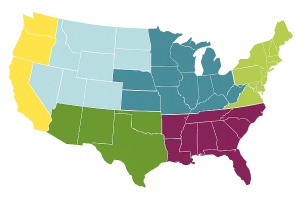Bearded Iris Care: How to Avoid 5 Common Growing Problems
Posted By American Meadows Content Team on Jul 19, 2016 · Revised on Oct 3, 2025

Knowing your location helps us recommend plants that will thrive in your climate, based on your Growing Zone.
Posted By American Meadows Content Team on Jul 19, 2016 · Revised on Oct 3, 2025
Although Bearded Iris are fairly low-maintenance once established in your garden, there are five common growing problems that you'll want to be aware of. These issues can cause your Iris to produce less blooms – or even prevent them from making it through the growing season! The good news is that these problems are fairly simple to resolve. With just a little know-how in the Bearded iris care department, soon enough you’ll love this easy-growing, beautiful plant.
We'll Cover 5 Common Bearded Iris Growing Problems

This is one of the most common reasons that Bearded Iris do not grow or produce the big, fabulous blooms they're known for. Bearded Iris rhizomes should not be buried completely underground, but instead, they should remain exposed at the surface. The tops of the rhizomes should be visible and you should be sure to spread the roots out as you bury them below the soil.
Bearded Iris are propagated and planted as rhizomes, sideways-growing stems that shoot out laterally, just beneath the surface of the soil. Each new shoot begins to form new roots and shoots of its own. Plants use rhizomes for food storage. Ginger, turmeric, and Canna are all well-known rhizomes.
If you have heavy rains or planted your Bearded Iris in an area that tends to hold standing water, you may experience bacterial rot in your tubers.
How Do You Spot Rhizome Rot in Bearded Irises?
To Remediate Rhizome Rot:
To avoid rhizome rot, be sure to plant your Bearded Iris in an area with good drainage. If you don’t have any beds with good drainage, consider building a raised bed or adding peat moss to your soil. Overcrowding can also cause rhizome rot so make sure to start your Bearded iris out with plenty of room to grow.
Bearded Iris love sun, sun, sun! They need at least six hours of direct sunlight in most climates.
Be sure to choose a full-sun location when planting your Bearded Iris rhizomes.
If your Irises are not thriving in their current location, they can easily be transplanted to a new garden bed with full sun.
Lots of sunshine also helps to prevent problem #2 (rhizome rot).

Pests and diseases in Bearded Iris often vary by geographic location and gardening conditions. One general rule of disease prevention is to keep your garden clean from debris and weeds as much as possible. Having said that, pests and diseases can show up in even the most pristine gardens, so it is good to learn how to diagnose and treat these issues.
Bacterial Leaf Spot (Disease)
Fungal Leaf Spot (Disease)
Aphids (Pest)
Iris Borer (Pest)

Divide and conquer! Every three to five years, Bearded Iris tend to become overcrowded and the rhizomes should be divided. As a benefit, you get to add Bearded Irises to other parts of your garden free of charge! Plus, you'll be proactively preventing the spread of pests and diseases.
Basic Steps To Divide Bearded Iris: